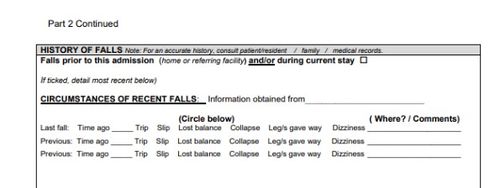The Of Dementia Fall Risk
The Of Dementia Fall Risk
Blog Article
Some Ideas on Dementia Fall Risk You Need To Know
Table of ContentsSome Known Factual Statements About Dementia Fall Risk Dementia Fall Risk for DummiesA Biased View of Dementia Fall RiskThe smart Trick of Dementia Fall Risk That Nobody is Talking About
An autumn danger assessment checks to see how most likely it is that you will certainly fall. The analysis normally includes: This consists of a collection of concerns regarding your overall health and if you have actually had previous falls or troubles with equilibrium, standing, and/or walking.STEADI consists of testing, examining, and intervention. Treatments are suggestions that may lower your danger of falling. STEADI consists of three actions: you for your danger of succumbing to your danger elements that can be boosted to try to avoid drops (for example, equilibrium issues, impaired vision) to minimize your risk of falling by utilizing efficient approaches (as an example, supplying education and resources), you may be asked numerous questions consisting of: Have you fallen in the past year? Do you really feel unsteady when standing or walking? Are you stressed over dropping?, your supplier will check your strength, balance, and stride, using the complying with fall evaluation devices: This test checks your stride.
If it takes you 12 seconds or more, it might suggest you are at greater threat for a loss. This examination checks toughness and equilibrium.
Move one foot midway onward, so the instep is touching the large toe of your other foot. Move one foot fully in front of the other, so the toes are touching the heel of your other foot.
What Does Dementia Fall Risk Mean?
A lot of falls take place as an outcome of several adding aspects; for that reason, handling the risk of dropping begins with determining the elements that add to drop risk - Dementia Fall Risk. Some of one of the most pertinent danger elements consist of: History of previous fallsChronic clinical conditionsAcute illnessImpaired gait and balance, lower extremity weaknessCognitive impairmentChanges in visionCertain high-risk drugs and polypharmacyEnvironmental elements can likewise boost the risk for falls, consisting of: Insufficient lightingUneven or harmed flooringWet or slippery floorsMissing or damaged handrails and get hold of barsDamaged or incorrectly fitted equipment, such as beds, wheelchairs, or walkersImproper usage of assistive devicesInadequate guidance of the individuals staying in the NF, including those who exhibit hostile behaviorsA successful loss threat monitoring program requires a comprehensive clinical evaluation, with input from all members of the interdisciplinary group

The treatment strategy should also include treatments that are system-based, such as those that promote a safe atmosphere (ideal illumination, handrails, grab bars, and so on). The efficiency of the treatments must be examined occasionally, and the care plan revised as needed to reflect modifications in the autumn threat evaluation. Carrying out a loss risk management system utilizing evidence-based ideal technique can decrease the prevalence of falls in the NF, while restricting the potential for fall-related injuries.
The Greatest Guide To Dementia Fall Risk
The AGS/BGS standard recommends screening all grownups matured 65 years and older for loss risk each year. This screening includes asking individuals whether they have actually fallen 2 or more times in the past year or sought clinical interest for a fall, or, if they have actually not dropped, whether they feel unsteady when walking.
Individuals that have actually fallen as soon as without injury needs to have their equilibrium and gait assessed; those with gait or balance abnormalities should get added analysis. A background of 1 autumn without injury and without stride or equilibrium issues does not call for more analysis past continued yearly autumn threat screening. Dementia Fall Risk. A loss danger assessment is required as part of the Welcome to Medicare assessment

What Does Dementia Fall Risk Mean?
Recording a falls history is one of the top quality indications for fall prevention and monitoring. Psychoactive medications in specific are independent predictors of falls.
Postural hypotension can usually be minimized by reducing the dosage of blood pressurelowering medications and/or site web quiting drugs that have orthostatic hypotension as a side impact. Use above-the-knee support hose pipe and copulating the head of the bed raised might additionally minimize postural decreases in blood pressure. The advisable components of a fall-focused checkup are revealed in Box 1.

A Pull time higher than or equivalent to 12 secs recommends high fall risk. Being not able to stand up from a chair of knee height without utilizing one's arms shows boosted autumn risk.
Report this page